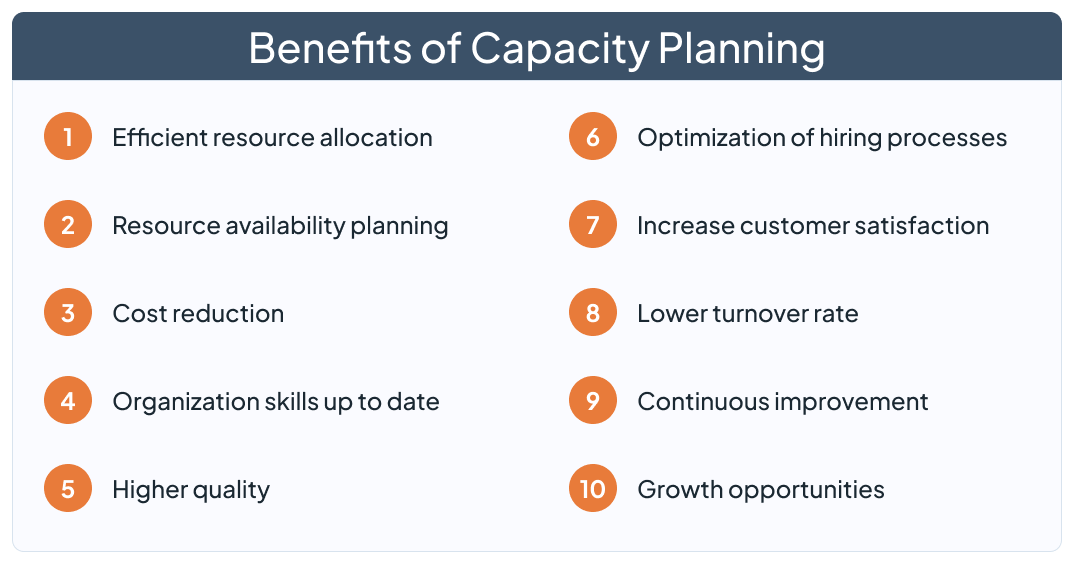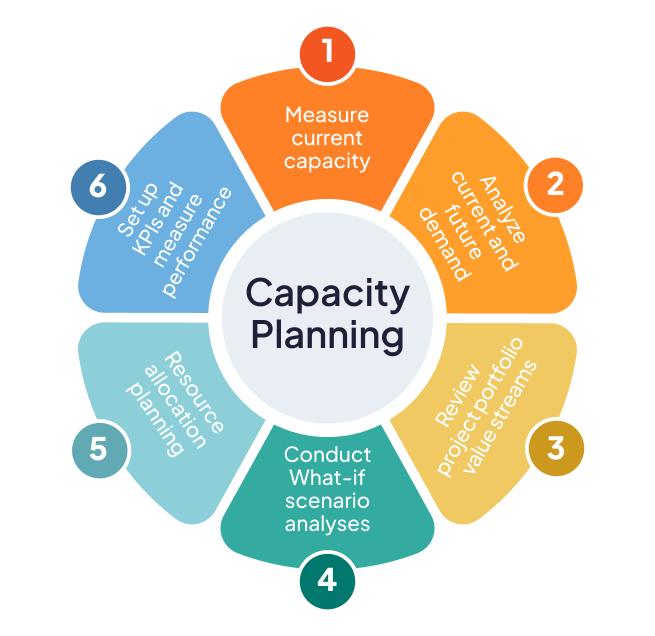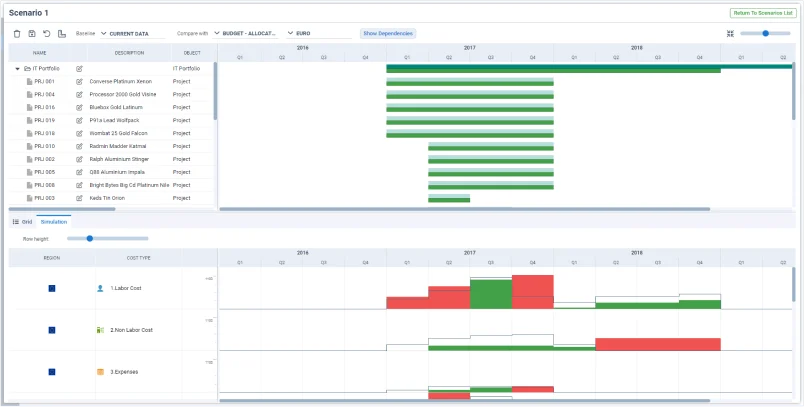10 Benefits of Capacity Planning for Medium and Large corporations

Are you struggling to cope with all the large incoming demand? Do you consider the overall goals and plans of your organization when deciding which projects to prioritize and assigning resources to them? Does your organization have a high turnover rate mainly because your teams are overloaded with work?
Many organizations face problems of this nature on a daily basis. And all of them could be addressed if capacity planning processes are put in place. In this post, we’ll explain the 10 main advantages that Capacity Planning will bring to medium and large companies.
TABLE OF CONTENTS
- What is Capacity Planning.
- Benefits of Capacity Planning for Medium and Large Corporations.
- Strategic Resource allocation.
- Plan ahead resource availability.
- Reduce Resource Management costs.
- Anticipate the skills your organization will need.
- Optimization of staffing processes.
- Improve the quality of your projects, products and services.
- Higher customer satisfaction.
- Lower employee turnover rate.
- Process based on continuous improvement.
- Increased growth opportunities.
- Conclusion.
What is Capacity Planning
Before going into detail about the benefits of capacity planning, first let’s define the term capacity planning.
Capacity planning is the process by which a business estimates whether it has the resources and skills necessary to meet all incoming demand for a given period. And, based on those estimates, distribute that capacity across the different projects and initiatives the organization is working on depending on their priority for the business.
It is a process based on continuous improvement that, if well executed, will bring countless benefits to your organization. If you want more information on what Capacity Planning is, how to define the process and best practices to follow, we recommend you checking our post ‘What is Capacity Planning and why is critical for business performance?’
Benefits of Capacity Planning for Medium and Large Corporations
In these times, medium and large corporations must cope with a higher volume of demand from their customers and users. In addition, being able to have the necessary resources to meet this demand is very complicated due to the increasingly competitive labor market. That´s why having processes in place for capacity planning is critical for business performance.
Capacity planning allows companies to be more efficient and competitive
See the Triskell platform in action in a personal demo
It is a process that will enable organizations to be more efficient and competitive in their markets. And they will also see a significant improvement in the quality of their products and services, as well as in the satisfaction level of both customers and their own employees.
In total, we will list 10 benefits that capacity planning will bring to your organization.
1. Strategic Resource allocation
How many times have strategic projects not been properly executed due to a lack of adequate resources in the organization? Or that the productivity of your most valuable resources has been squandered on projects of low relevance?
Capacity planning is the artifact that will help you connect strategic planning with successful execution. It is a process through which you will be able to connect initiatives, priorities, objectives, budget and resources, allowing you to:
- Assign the necessary and relevant skills to each of the organization’s initiatives.
- Detect early the skills gaps that are vital to the execution of your most important portfolios.
- Prioritize or put on hold projects depending on the availability or unavailability of resources and adequate skills for their proper performance.
2. Plan ahead resource availability
How many initiatives have you had to cancel or postpone because you did not foresee the availability of resources? Or how many area managers have been reluctant to give up their resources because the day-to-day operations of their teams would be compromised?
Planning capacity every 3 to 6 months will give you an overall map of your organization’s resources, skills, or current and future workload. Data with which you can make informed decisions about:
- Resource allocation.
- Projects and programs prioritization.
- Budget and cost planning of your project portfolios.
- The need to invest in new staff, internal or external to the organization.
3. Reduce Resource Management costs
How many projects have you not been able to complete within the agreed budget due to unplanned expenses for hiring resources? How much money do you think your organization would save if it managed to plan resource allocation?
Another advantage of capacity planning is that it will help you to make resource management more efficient. By having your organization’s resources and skills listed, you will be able to see how they are being used and detect opportunities for improvement through which to make decisions that will help your business grow.
Capacity Planning will allow you to optimize the expenses derived from Resource Management
See the Triskell platform in action in a personal demo
For example, you will be able to optimize the costs derived from Resource Management and Capacity Planning. Is it necessary to hire new staff or the services of an agency or consulting firm to acquire certain skills for the organization? Or do we schedule in-house training for those resources who, by career path, would learn those skills faster? Depending on variables such as priority, budget, risks, or duration of the initiatives that require these skills, you will be able to choose the best option for the business.
4. Anticipate the skills your organization will need
Have you had issues with resource allocation planning because you didn’t have a detailed list of your teams’ skills? Have you been unable to meet deadlines for certain projects because the resources working on those projects did not have the necessary skills to successfully undertake them?
Having an overview of your organization’s skills will allow you to successfully plan resource allocation, which will positively impact the health of the business in several ways. For example:
- Hire new resources once skills deficiencies are detected.
- Allocate the right resources to the right projects, which will improve the success rate of the projects.
- Keep your teams and resources motivated by having them work on the initiatives that are most relevant to their day-to-day operations.
5. Optimization of staffing processes
How many times did you have to stop some of your initiatives or projects because the selection process for new personnel took too long? Or did you realize that you lacked certain skills already in the advanced stages of the project?
Planning capacity every 3 to 6 months will help optimize your staffing processes
See the Triskell platform in action in a personal demo
One of the main benefits of capacity planning is that, if the process is executed 3 to 6 months in advance, your organization will gain agility in reacting to these types of events. You will be able to plan in advance the hiring of new staff to your teams. And, depending on the competencies and priority of the project portfolios in which these resources will be involved, will be able to define more accurately:
- A list of skills your resources need to have.
- If you must hire new staff or outsource the services of an external partner.
- The type of contract the new resources will have. Depending on the reality of your organization and the duration and priority of product and project portfolios you manage, the working relationship with the resources may vary.
6. Improve the quality of your projects, products and services
Have there been any initiatives that did not produce the expected outcome because your organization did not have the right resources and skills? Did this also result in poor customer and user experience because of the outcome of the project?
Organizations’ success is measured by the perceived quality of the different products and services they bring to market. And achieving the quality standards agreed with stakeholders is easier if you have the most relevant resources and skills for the initiatives you are working on.
7. Higher customer satisfaction
Customer and user satisfaction is a critical indicator that organizations must take into account when measuring the performance of their product and project portfolios:
- Are you providing the products and services expected of you?
- Do your initiatives meet the agreed quality standards?
- Are your project and product portfolios delivered on time and on budget?
Capacity planning is critical to leading your company to success. With this process, you will find the perfect balance between project prioritization, resource allocation and budget and cost management without compromising the profitability and performance of your project and product portfolios.
8. Lower employee turnover rate
Is there a high turnover rate in your organization? Do you detect frustration and burnout in your teams? Do your projects or programs suffer delays mainly because your teams are overwhelmed with work?
If you detect these symptoms, it means that you do not have efficient capacity planning processes in place. In terms of team morale, capacity planning will help to:
- Plan in advance the hours required for your project and product portfolios, which will help prevent the team from being unnecessarily overloaded with work.
- Improve employee satisfaction by assigning them to initiatives that best fit their skills and career path.
- Improve the level of commitment and loyalty to the organization of your most valuable resources.
Capacity Planning process will help to increase employee satisfaction and loyalty
See the Triskell platform in action in a personal demo
9. Process based on continuous improvement
Capacity planning is not a one-time process. It is an iterative process that, although it should be planned 3 to 6 months ahead, should have a long-term purpose.
Over time you will detect problems and bottlenecks in the process and identify new incoming demand trends. In short, you will gain experience to address the different challenges that may arise when planning resource allocation or when filling skills gaps in the organization to meet the demand.
The point is: do NOT question the capacity planning process, no matter how many problems and obstacles you encounter along the way. It must be optimized as these challenges arise, as the organization will gain in efficiency and excellence.
10. Increased growth opportunities
And lastly, as you refine your capacity planning processes, you will see how this positively impacts business performance in a variety of ways:
- A higher success rate of the projects and initiatives you embark on.
- Increased customer and user satisfaction and, therefore, more profits for the business.
- More agility in addressing new strategic challenges.
- Higher employee retention rate, which will help the organization to reduce the cost of hiring new personnel.
- More and better-qualified teams and resources.
Conclusion
Now that you know all the benefits that Capacity Planning will bring to your organization, what are you waiting for to put the process into practice? But beware, it is a process that cannot be managed with spreadsheets, but with tools designed to get the most out of Data Analytics and Business Intelligence.
A PPM software like Triskell with Resource Management capabilities is what you need to successfully plan your organization’s capacity. What-if Scenario Simulation, Gantt charts, Timesheets or scoring models for incoming demand are just some of the features that will take your Resource Management and Demand and Capacity Planning processes to the next level.
Subscribe to our Newsletter
Get stories like this in your inbox
Request a demo of Triskell Software
Do you think Triskell Software is the solution you need to take your organization’s resource management to excellence? If so, request a demo of Triskell.

FAQs about the benefits of
capacity planning
How can capacity planning improve project quality?
Capacity planning directly impacts project quality by ensuring teams aren’t overloaded. Imagine a team juggling too many tasks – mistakes are more likely, deadlines get missed, and corners are cut.
Capacity planning allocates resources strategically, giving teams the bandwidth to focus on quality deliverables. This translates to fewer errors, a higher focus on details, and ultimately, a better end product.
How can capacity planning help with cost reduction?
Overbooking resources or relying on expensive external help can significantly inflate project costs. Capacity planning helps you avoid both these pitfalls.
By understanding team capabilities and project demands, you can identify skill gaps and plan resource allocation efficiently. This minimizes unnecessary hiring and ensures you’re utilizing internal resources effectively, leading to cost reduction.
Does capacity planning improve product and service quality?
Yes, absolutely. Just like project quality, product and service quality are directly linked to resource capacity. When teams are stretched thin, the focus shifts from quality to simply completing tasks.
Capacity planning ensures teams have the time and resources needed to deliver high-quality work. This translates to fewer defects in products and a higher standard of service for your customers.
How can I get started with capacity planning?
Getting started with capacity planning is easier than you might think. Here’s a simple breakdown:
- Assess current resources: Start by taking stock of your team’s skills, experience, and current workload.
- Identify upcoming projects: List upcoming projects and analyze the specific skill sets required for each.
- Plan Resource Allocation: Match project needs with available resources. Identify any skill gaps that need to be addressed.
- Develop a Strategy: Create a plan for allocating resources effectively. This might involve adjusting project timelines, hiring or training for skill gaps, or utilizing external resources strategically.
Related Content

Why the CIO needs a PMO approach
Unlock business success: discover why the CIO must embrace a PMO approach! to elevate efficiency and boost productivity.

Lean Budgeting for Agile Portfolios: A Comprehensive Guide
Lean Budgeting: the financial revolution for Agile portfolios. Discover how to streamline project financing and optimize value delivery.

Implementing SAFe with a 7-step roadmap
Do you want to scale Agile at the enterprise level and don’t know where to start? We solve your doubts by explaining the steps to implement SAFe.





